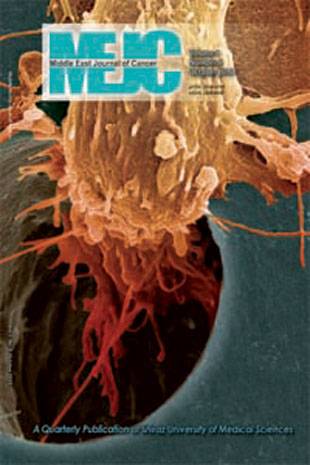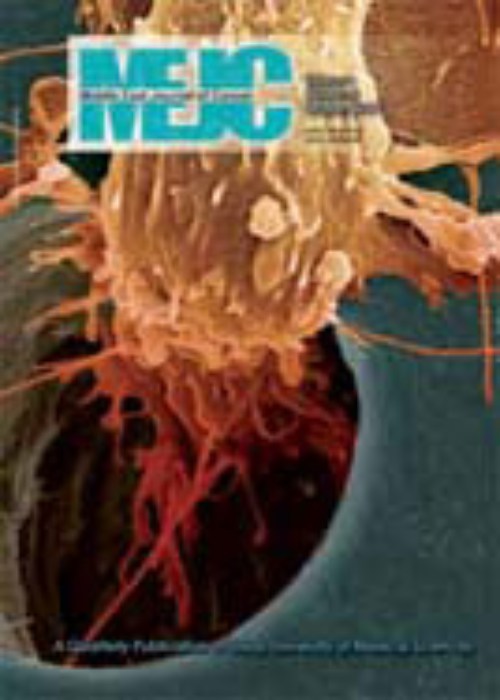فهرست مطالب

Middle East Journal of Cancer
Volume:2 Issue: 2, Apr 2011
- تاریخ انتشار: 1390/10/19
- تعداد عناوین: 7
-
-
Page 51BackgroundThe present study aimed to compare the rates of complete clinical and pathologic response to docetaxel, doxorubicin and cyclophosphamide (TAC) vs. 5-fluorouracil, doxorubicin and cyclophosphamide (FAC) as neoadjuvant chemotherapy in women with locally advanced breast cancer.MethodsOne hundred women with pathologically confirmed newly diagnosed locally advanced (T3-T4 or N2-N3) breast cancer were randomly assigned to receive a median of four cycles of either 5-fluorouracil (600 mg/m2), doxorubicin (60 mg/m2) and cyclophosphamide (600 mg/m2) every three weeks or docetaxel (75 mg/m2), doxorubicin (50 mg/m2) and cyclophosphamide (500 mg/m2) every three weeks followed by modified radical mastectomy. Complete clinical and pathologic response rates and toxicity were the primary and secondary outcome measures of the study.ResultsMedian age for all patients was 43.4 years (range 25-63 years). Patients in the TAC arm achieved a higher clinical (16%) response rate than those in the FAC arm (4%, P=0.046). The pathologic response rate was also higher in the TAC arm compared to the FAC arm [TAC (20%) vs. FAC (6%), P=0.037]. Estrogen receptor- negative status correlated with a higher clinical [TAC (19%) vs. FAC (4%), P=0.032] and pathologic [TAC (23%) vs. FAC (4%), P=0.011)] response rate in both arms. All patients generally tolerated treatment well, and treatment-related toxicities were manageable.ConclusionCombined treatment with TAC led to higher rates of complete clinical and pathologic response with acceptable toxicity compared to FAC in patients with locally advanced breast cancer. However, further follow-up is needed to translate this response into improvements in survival.
-
Page 59BackgroundWe conducted a retrospective analysis to evaluate overall survival (OAS) and disease free survival (DFS) rates in patients with squamous cell carcinoma of the urinary bladder according to different prognostic factors.MethodsThis retrospective study analyzed the medical records of patients with non-metastatic squamous cell carcinoma of the urinary bladder. All men underwent radical cystectomy and women underwent anterior pelvic exentration. Most patients had postoperative radiation therapy. The log-rank test examined differences in OAS and DFS rates.ResultsThe medical records of 106 patients were analyzed. The median follow- up from the date of enrollment was 30 months and ranged from 2 to 73 months. For the entire group, three-year OAS rates were 46.9% and DFS rates were 44%. For patients with P2 (tumor invasion into the muscularis propria) the three-year OAS rate was 53%, for P3 (tumor invasion into perivesical fat) it was 45% and 9% for P4 (tumor invasion into adjacent organs, pelvic wall or abdominal wall) The OAS rate was statisticallysignificant in favor of P2 disease (P=0.0041). The three-year DFS rate was 50% for P2, 45% for P3 and 9% for P4 disease (P=0.0125). Administration of post-operative radiotherapy did not result in statistically significant improvement in three-year OAS and DFS rates.ConclusionSurvival rates were statistically significant and higher in patients with P2 and P3 disease compared to P4 disease. Adjuvant radiotherapy did not result in statistically significant survival improvement.
-
Page 65BackgroundSeroma formation is a common problem following axillary dissection. It is probably caused by a local inflammatory response. Local steroids may prevent this problem by inhibiting inflammatory response at the wound site.MethodsThis randomized prospective study was undertaken to evaluate the effect of local triamcinolone injection on seroma formation following axillary dissection. In addition, other wound complications were recorded. A total of 44 women who underwent axillary dissection were randomized to receive either 40 mg intracavitary triamcinolone (Group T, n=22) or saline (Group C, n=22) on their first postoperativevisit. Drains were removed if 24-hour drainage was <50 mL. The incidence of wound complications (including seroma) during the first postoperative month was recorded. Additionally, some patient and tumor characteristics possibly pertinent to wound complications were assessed.ResultsNo wound complications (including seroma formation) were observed in either group in four follow-up visits during the first month after surgery.ConclusionIn our study, in contrast to previous studies, seroma formation was not a common complication following axillary dissection. We could not evaluate the effect of local triamcinolone on seroma formation, although it apparently had no unfavorable effect on this potential complication. According to this study, axillary dissection can be a safe procedure if optimal surgical techniques and meticulous dissections are used, and if drain removal is timed appropriately.
-
Page 71BackgroundBreast cancer is the most common cancer among Jordanian women, yet survival data are scarce. This study aims to assess the observed five-year survival rate of breast cancer in Jordan from 1997 to 2002 and to determine factors that may influence survival.MethodsData were obtained from the Jordan Cancer Registry (JCR), which is a population-based registry. From 1997-2002, 2121 patients diagnosed with breast cancer were registered in JCR. Relevant data were collected from JCR files, hospital medical records and histopathology reports. Patient's status, whether alive or dead, was ascertained from the Department of Civil Status using patients’ national numbers (ID). Statistical analysis was carried out using SPSS (version 10). Survival probabilities by age, morphology, grade, stage and other relevant variables were obtained with the Kaplan Meier method.ResultsThe overall five-year survival for breast cancer in Jordan, regardless of the stage or grade was 64.2%, meanwhile it was 58% in the group aged less than 30 years. The best survival was in the age group 40-49 years (69.3%). The survival for adeno carcinoma was 57.4% and for medullary carcinoma, it was 82%. The survival rate approximated 73.8% for well-differentiated, 55.6% for anaplastic, and 58% for poorly differentiated cancers. The five-year survival rate was 82.7% for stage I, 72.2% for stage II, 58.7% for stage III, and 34.6% for stage IV cancers.ConclusionAccording to univariate analysis, stage, grade, age and laterality of breast cancer significantly influenced cancer survival. Cox regression analysis revealed that stage, grade and age factors correlated with prognosis, while laterality showed no significant effect on survival. Results demonstrated that overall survival was relatively poor. We hypothesized that this was due to low levels of awareness and lack ofscreening programs.
-
Page 81BackgroundThe present study aimed to report the characteristics and treatment outcomes of five patients with nasopharyngeal adenoid cystic carcinoma and a literature review.MethodsBetween 2000 and 2009, five consecutive patients (4 men, 1 woman) were diagnosed with nasopharyngeal adenoid cystic carcinoma and treated at our institution. Three patients had stage IVa (T4N0M0) and two patients had stage III (T3N0M0) cancer. Primary treatment consisted of concurrent chemoradiation in three patients and radiotherapy alone in two patients. Surgery was limited to endoscopic biopsy for histological diagnosis.ResultsFour patients achieved complete response during or after completion of treatment and remained free of disease for a median of 27 months. Four patients developed local recurrence 8-30 months after initial treatment. The fifth patient is alive and free of disease.ConclusionThe findings of the present study and literature review suggest that local failure is a major problem in adenoid cystic carcinoma of the nasopharynx.
-
Page 87The association of squamous cell carcinoma of the larynx with thyroid papillary carcinoma is an unusual finding. From 2004 to 2011, approximately 250 patients underwent laryngectomies due to squamous cell carcinoma of the larynx at the Otolaryngology Department of Khalili Hospital, affiliated with Shiraz University of Medical Sciences, Shiraz, Iran. In three patients, synchronous occurrence of squamous cell carcinoma and thyroid papillary carcinoma was found. Histopathologic study of the lymph nodes revealed metastatic papillary thyroid carcinoma in one case. We report three cases of thyroid papillary carcinoma incidentally found on histological examinations of resected thyroid lobes, as a procedure required for treatment of head and neck squamous cell carcinoma. In comparison, laryngeal squamous cell carcinoma needs more aggressive treatment than well-differentiated thyroid carcinoma. The prevalence of thyroid papillary carcinoma, as an incidental finding in our study was 0.01%. Therefore, preoperative evaluation of the thyroid gland by ultrasonography and fine needle aspiration biopsy of suspicious lesions is recommended in patients who are candidates for open laryngectomy.


